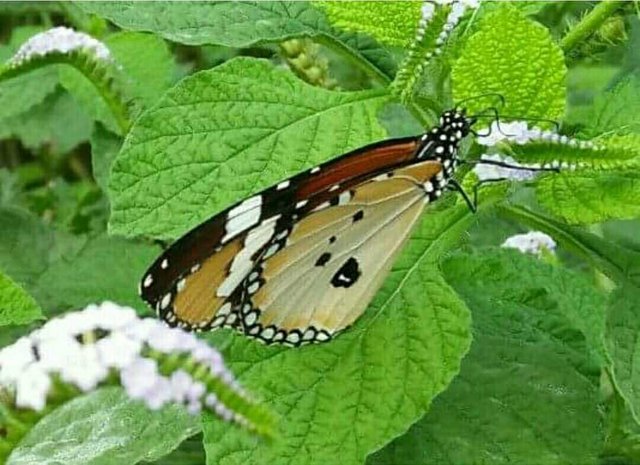UNIQUE FACTS ABOUT BUTTERFLIES
Good afternoon steemit friends all.

From small to large ones with various shades, butterflies have a beautiful color. Everyone is familiar with butterflies. Here are the unique facts about the natural "flying flower".
Butterfly wings are transparent.
How come? What we know butterflies have the most colorful and striking wings! Well, the butterfly wings are actually formed from the layers of chitin, a protein that forms an exoskeleton of insects. These layers are so thin you can see through them. Thousands of small scales envelop this transparent chitin and these scales reflect light in different colors. As the butterfly gets older, it will bring up a transparent point where its chitin layers will be exposed. So the older the butterfly, the wings will appear more transparent.
Butterfly tasted something with his feet.
The taste receptor at the butterfly's feet helps him find the host plant and track his food. A female butterfly lands on different plants, wiggling its leaves with its feet to make the plant release its "juice". The tissue behind the legs has chemoreceptors that detect suitable plant chemical pairs. When he identifies the right plant, he will lay eggs. A butterfly will also step on its food, using an organ that can feel the sugar dissolves to taste food sources such as ripe fruit.
The butterfly diet depends on the liquid type.
Speaking of the butterfly diet, adult butterflies only eat fluids, usually nectar. The portion of the mouth is modified to be able to drink, but they are not able to chew solid food. A proboscis / trunk that acts as a drinking straw, curls beneath the butterfly's chin until it finds a source of nectar, or other liquid nutrients. He will then stretch out the tubular structure to suck his food.
A butterfly must immediately combine proboscis / trunk it after exit from Chrysalis / cocoon.
A butterfly that can not drink the nectar is finished, so one of the main tasks of an adult butterfly is to make sure its mouth is functioning. When the new adult butterfly emerges from the pupa or cocoon pouch, its mouth is divided into 2 parts. Using a palpi located near his trunk, the butterflies begin to combine the two parts into 1 part of the mouth, tubular trunk. You will see the new butterfly coming out of the cocoon rolling up and sticking out its trunk to test its function.
Butterflies drink from mud.
A butterfly can not only live from sugar; he also needs minerals. To supplement the nectarine diet, a butterfly will suck on some mud, rich in minerals and salt a few times. These so-called puddling habits tend to be more often seen in male butterflies, as they are more in need of minerals for their sperm. These nutrients are then transferred to the female during mating which increases the resistance of the eggs.
If it is cold, butterflies can not fly.
Butterflies need ideal body temperature around 30ºC to fly. Since they are cold-blooded animals, they can not control their own body temperature. The temperature of the air around it has a big impact on their body's ability to function. If the air temperature falls below 13ºC, butterflies can not move, can not escape from predators as well. When the air temperature ranges at 28 º-38 º C, butterflies can fly easily. A cold day obliges the butterfly to warm up to its flying authority, either by shaking or bathed in sunlight. Even sun-loving butterflies can also overheat when the temperature is above 38ºC, which will make them look for a cool place to cool themselves.
New butterfly "hatch" can not fly.
In a cocoon, a growing butterfly waits to hatch with its wings covering its body. When he came out of his cocoon, he welcomed the world with wilted, crumpled wings. The butterfly must immediately pump the body fluid into the wing vein to expand it. When the wings reach full size, the butterfly must rest for several hours to let the body dry and harden before flying for the first time. So, what you often see in the music video or movie clip is wrong, butterflies can not fly when hatched from the cocoon.
Usually butterflies only live for 2-4 weeks.
Once he came out of the cocoon as an adult butterfly, a butterfly had only a few weeks to live. Throughout this time, he will focus his energies on two things: eating and mating. Some of the smallest butterflies, which are blue, can last only a few days. Long-lived mature butterflies, such as monarchs or mourning cloaks, can live up to 9 months.
Butterflies are close-looking animals, but they can see and categorize lots of colors.
About 3-4 meters, butterfly view is quite good. Everything beyond that distance appears blurry for butterflies. Butterflies depend on their views for vital tasks, such as finding married mates of the same species or finding their food flower. In addition, butterflies can also see a vast range of ultraviolet colors, such as the human eye. They themselves have ultraviolet marks on their wings to get to know each other and to know their potential partners. Flowers also have ultaviolet signs that can be used to attract pollinating animals such as butterflies.
Butterfly is quite clever and has many tricks to be free from the predators.
Butterflies are in a very low position in the food chain, many predators are ready to target them. Some butterflies fold their wings to camouflage disguise themselves with nature, some also having the same color as the surrounding nature. While there are other species that use opposite strategies, their wings are made very bright and striking to announce their existence. Super-bright colored insects are usually considered toxic by predators so they are avoided, this is the strategy they use. Most of the butterflies are not poisonous, but they imitate other insects known toxic.